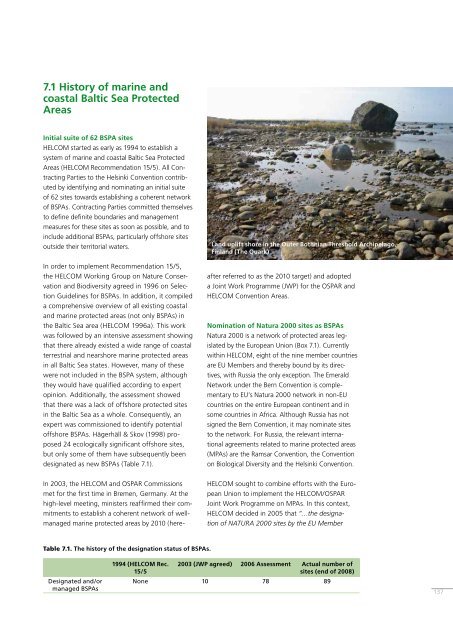BSEP116B Biodiversity in the Baltic Sea - Helcom
BSEP116B Biodiversity in the Baltic Sea - Helcom
BSEP116B Biodiversity in the Baltic Sea - Helcom
You also want an ePaper? Increase the reach of your titles
YUMPU automatically turns print PDFs into web optimized ePapers that Google loves.
7.1 History of mar<strong>in</strong>e and<br />
coastal <strong>Baltic</strong> <strong>Sea</strong> Protected<br />
Areas<br />
Initial suite of 62 BSPA sites<br />
HELCOM started as early as 1994 to establish a<br />
system of mar<strong>in</strong>e and coastal <strong>Baltic</strong> <strong>Sea</strong> Protected<br />
Areas (HELCOM Recommendation 15/5). All Contract<strong>in</strong>g<br />
Parties to <strong>the</strong> Hels<strong>in</strong>ki Convention contributed<br />
by identify<strong>in</strong>g and nom<strong>in</strong>at<strong>in</strong>g an <strong>in</strong>itial suite<br />
of 62 sites towards establish<strong>in</strong>g a coherent network<br />
of BSPAs. Contract<strong>in</strong>g Parties committed <strong>the</strong>mselves<br />
to def<strong>in</strong>e def<strong>in</strong>ite boundaries and management<br />
measures for <strong>the</strong>se sites as soon as possible, and to<br />
<strong>in</strong>clude additional BSPAs, particularly offshore sites<br />
outside <strong>the</strong>ir territorial waters.<br />
In order to implement Recommendation 15/5,<br />
<strong>the</strong> HELCOM Work<strong>in</strong>g Group on Nature Conservation<br />
and <strong>Biodiversity</strong> agreed <strong>in</strong> 1996 on Selection<br />
Guidel<strong>in</strong>es for BSPAs. In addition, it compiled<br />
a comprehensive overview of all exist<strong>in</strong>g coastal<br />
and mar<strong>in</strong>e protected areas (not only BSPAs) <strong>in</strong><br />
<strong>the</strong> <strong>Baltic</strong> <strong>Sea</strong> area (HELCOM 1996a). This work<br />
was followed by an <strong>in</strong>tensive assessment show<strong>in</strong>g<br />
that <strong>the</strong>re already existed a wide range of coastal<br />
terrestrial and nearshore mar<strong>in</strong>e protected areas<br />
<strong>in</strong> all <strong>Baltic</strong> <strong>Sea</strong> states. However, many of <strong>the</strong>se<br />
were not <strong>in</strong>cluded <strong>in</strong> <strong>the</strong> BSPA system, although<br />
<strong>the</strong>y would have qualified accord<strong>in</strong>g to expert<br />
op<strong>in</strong>ion. Additionally, <strong>the</strong> assessment showed<br />
that <strong>the</strong>re was a lack of offshore protected sites<br />
<strong>in</strong> <strong>the</strong> <strong>Baltic</strong> <strong>Sea</strong> as a whole. Consequently, an<br />
expert was commissioned to identify potential<br />
offshore BSPAs. Hägerhäll & Skov (1998) proposed<br />
24 ecologically significant offshore sites,<br />
but only some of <strong>the</strong>m have subsequently been<br />
designated as new BSPAs (Table 7.1).<br />
In 2003, <strong>the</strong> HELCOM and OSPAR Commissions<br />
met for <strong>the</strong> first time <strong>in</strong> Bremen, Germany. At <strong>the</strong><br />
high-level meet<strong>in</strong>g, m<strong>in</strong>isters reaffirmed <strong>the</strong>ir commitments<br />
to establish a coherent network of wellmanaged<br />
mar<strong>in</strong>e protected areas by 2010 (here-<br />
Land uplift shore <strong>in</strong> <strong>the</strong> Outer Bothnian Threshold Archipelago,<br />
F<strong>in</strong>land (The Quark)<br />
after referred to as <strong>the</strong> 2010 target) and adopted<br />
a Jo<strong>in</strong>t Work Programme (JWP) for <strong>the</strong> OSPAR and<br />
HELCOM Convention Areas.<br />
Nom<strong>in</strong>ation of Natura 2000 sites as BSPAs<br />
Natura 2000 is a network of protected areas legislated<br />
by <strong>the</strong> European Union (Box 7.1). Currently<br />
with<strong>in</strong> HELCOM, eight of <strong>the</strong> n<strong>in</strong>e member countries<br />
are EU Members and <strong>the</strong>reby bound by its directives,<br />
with Russia <strong>the</strong> only exception. The Emerald<br />
Network under <strong>the</strong> Bern Convention is complementary<br />
to EU’s Natura 2000 network <strong>in</strong> non-EU<br />
countries on <strong>the</strong> entire European cont<strong>in</strong>ent and <strong>in</strong><br />
some countries <strong>in</strong> Africa. Although Russia has not<br />
signed <strong>the</strong> Bern Convention, it may nom<strong>in</strong>ate sites<br />
to <strong>the</strong> network. For Russia, <strong>the</strong> relevant <strong>in</strong>ternational<br />
agreements related to mar<strong>in</strong>e protected areas<br />
(MPAs) are <strong>the</strong> Ramsar Convention, <strong>the</strong> Convention<br />
on Biological Diversity and <strong>the</strong> Hels<strong>in</strong>ki Convention.<br />
HELCOM sought to comb<strong>in</strong>e efforts with <strong>the</strong> European<br />
Union to implement <strong>the</strong> HELCOM/OSPAR<br />
Jo<strong>in</strong>t Work Programme on MPAs. In this context,<br />
HELCOM decided <strong>in</strong> 2005 that “…<strong>the</strong> designation<br />
of NATURA 2000 sites by <strong>the</strong> EU Member<br />
Table 7.1. The history of <strong>the</strong> designation status of BSPAs.<br />
Designated and/or<br />
managed BSPAs<br />
1994 (HELCOM Rec.<br />
15/5<br />
2003 (JWP agreed) 2006 Assessment Actual number of<br />
sites (end of 2008)<br />
None 10 78 89<br />
137

















